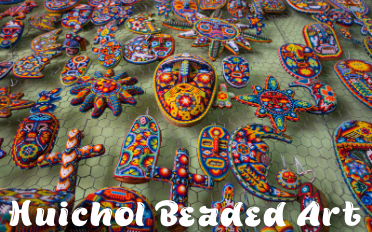The Fascinating History of Intricately Beaded Huichol Art All Entries

While Huichol art is a relatively wide umbrella term, it is commonly thought to encompass the production of beaded and string art (the former of which developed out of the latter), which is always brightly colored and features symbols, animals and designs which are centuries old and of great significance to the Wixáritari people.
The rugged mountains and remote villages of the Sierra de Nayarit north of Guadalajara are the homeland of roughly ten to fourteen thousand Huichol Indians. These were among the last tribes to come under Spanish rule, and their religion still is essentially pagan, revolving around several important agricultural deities. Deer is the most sacred of all animals, its blood a symbol of fertility. Corn is the source of all life, for it was Nacahue, mother of all gods, who gave corn to the first man for planting, and from it was born the first Huichol woman. Peyote is a means of communication with the gods, and the consumption of peyote by the Huichol people is a deeply religious experience. The unity of these three elements — deer, corn, and peyote — is the absolute core of Huichol beliefs.
The Huichols express these feelings through their art, which is made not from the standpoint of decoration, but to give profound expression to deep spiritual beliefs. This makes traditional Huichol art, whether it be meticulous beadwork, yarn paintings, wooden masks, or striking embroidered and woven personal adornments, beautiful not only from its aesthetic standpoint but from the psychological as well.
The origin of Huichol art lies in an ancient tradition, physical transcription of the images displayed by the Huichol shamans; induced by ingestion of peyote (hikuri), their sacred cactus, allowing them to cross the threshold of the unknown and thus relate to the divine. These works of art Huichol are made with beads or thread (yarn), each carries symbolic motifs, stories Huichol Huichol culture and legends of their cosmogony that we provide an overview of the Huichol society.
Initiation ritual art: Belonging to the specific religious practice of an indigenous group, the Huichol art is different from the contemporary art usually found in museums and galleries dimensions. The Huichol world is divided into three worlds: the mythology, the Huichol holds that life began in the ocean; the reference to corn, where daily life and develops Huichol traditions and that has to do with mysticism, which reveals the Huichol art world and its rituals that distinguishes them and give them identity as Huichol community.
While the origin of this fascinating ethnic Huichol is uncertain, what is indisputable is that during the period of the conquest, many survivors of various indigenous peoples mainly Huichol fled into the Sierra Madre Occidental to escape the wake of destruction left by the Spanish troops.
The Huichol art is a form of writing, as through the creations, the Huichol tell us their stories and myths. In each Huichol crafts leave a piece of your life. Currently, one can say that no other ethnic group in Mexico that conserve so deeply their beliefs, cults and traditions as the Huichol.
Ancestors born: The Huichol Art has an enigmatic beauty that takes us through mythical roads and brings us closer to the beginning of time in the Huichol culture, but not just Huichol myths drawn by the Huichol artists performing drawing them into yarn or thread in Huichol religion, the world exists thanks to the visionary experience of the Huichol started and its effort to get the "nierika" or "gift of seeing". Thus, for the Huichol Huichol artistic creation it has a cosmological dimension.
For the Huichol, the world has a sacred dimension to which the mara'akame (shaman) penetrates through sleep, establishing a link between the world of the gods and profane.



